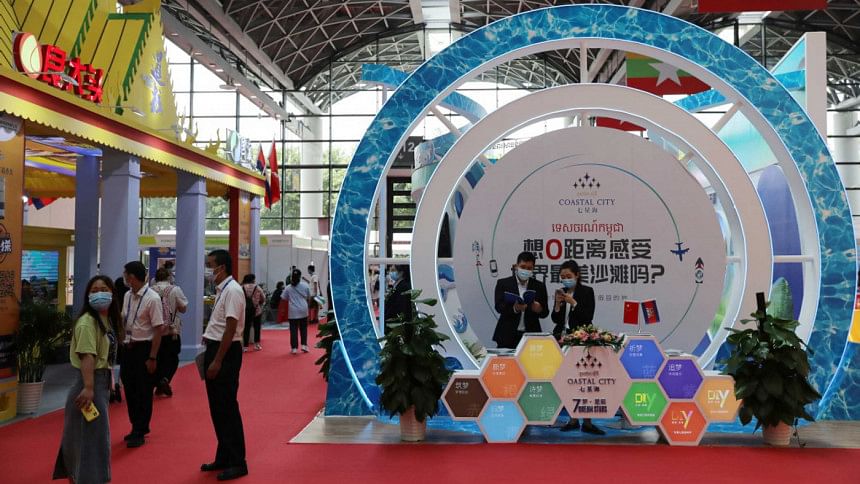Chinese trade expos are gateways to export opportunities

The South Asian developing countries today face challenges of economic vulnerability due to the Covid-19 pandemic, climate change and the rise of serious geopolitical rivalry posed by emerging military groupings and showdowns. Simultaneously, a rising trend of trade protectionism, with new hidden barriers and deglobalisation in the global market, are restricting the ability of the economic and investment sectors to promote global trade sustainably. In this context, China's open door and cooperation policy offers some opportunities for the region's prosperity and development, resuming economic growth at a faster rate. In order to fulfil President Xi Jinping's pledge to turn the Chinese market into a market for the world—a market shared by all and accessible to all—China has taken a number of concrete steps in recent years, including an all-round opening-up strategy that allows foreign enterprises greater access to the domestic market, and a foreign investment law that ensures a business-friendly environment. At the same time, China has taken new steps to strengthen bilateral, multilateral, and regional cooperation by joining trade blocs such as the Regional Comprehensive Economic Partnership (RCEP), and the Comprehensive and Progressive Agreement for Trans-Pacific Partnership (CPTPP), hosting a series of mega trade exhibitions and improving connectivity through the Belt and Road Initiative (BRI).
Of them, China Import and Export Exhibition (Canton Fair), China International Import Expo (CIIE), China International Fair for Trade in Services (CIFTIS), China-Asean Expo, China-South Asia Expo, Euro-Asia Economic Forum and Trade Cooperation Expo, Intertextile Shanghai Apparel Fabrics, and China Yangling Agricultural High-Tech Fair are all key exhibitions that will undoubtedly be of great significance to developing economies like Bangladesh. It is expected that Bangladesh's participation in these forums would open vistas of business opportunities and further enhance bilateral relations and cooperation.
According to government data, from January to July in 2021, the overall import-export volume between Bangladesh and China was USD 13 billion—a 58.9 percent increase year on year. Despite the fact that bilateral trade favours China heavily, Bangladesh has enormous potential that has yet to be realised. Dr MA Razzaque, head of the Dhaka-based Research and Policy Integration for Development (RAPID), conducted a research that showed that Bangladesh could earn USD 25 billion if it could grab only one percent share of China's imports. It should be noted that China imported goods worth USD 2.4 trillion in the 2019-20 fiscal year, in which Bangladesh's share was highly insignificant—just 0.05 percent. In the next 10 years, China is expected to import a total of USD 22 trillion worth of goods. Hence, China's exposition platforms will provide a great opportunity for Bangladesh to explore the vast Chinese market and expand export opportunities, to bridge the bilateral trade gap and increase revenue.
Bangladesh's major export items—ready-made garment (RMG) products, leather goods, jute and jute goods, agricultural products, frozen and live fish, pharmaceutical products, plastic, sports goods, handicrafts, and tea—have a strong competitive edge in the international market. But its limited export destinations—mainly the US and the European Union—may put Bangladesh in a more challenging position in future, especially as the US suspended the Generalised System of Preferences (GSP) for Bangladesh in June 2013 and India imposed anti-dumping duty on the export of Bangladeshi jute goods in January 2017 for a period of five years. It should also be noted that there is no guarantee to get into the EU's GSP+ scheme on expiry of the EBA initiative, after Bangladesh officially graduates from the LDC group in 2026. Amid such looming economic uncertainty, the good news is that China has provided duty-free access to 97 percent of Bangladeshi products (a total of 8,256 products) from July 2020. The expos are important ways to learn about Chinese consumer preferences and to tap into the vast market. Participating in these expos, Bangladesh can display and popularise its flagship products and diversify its export destinations as a large number of buyers, entrepreneurs and companies from Europe, America, Australia, Southeast Asia, Middle East, and Africa will be in attendance there. For example, the China-Asean Expo (CAEXPO) could give Bangladesh trilateral trade expansion opportunities to enter markets in China as well as the Association of Southeast Asian Nations (Asean), which has a combined population of two billion and a GDP of USD 18.5 trillion.
Bangladesh's development-first strategy, a 165-million-strong population, low- cost and skilled labour market, appealing geostrategic location, and investment-friendly policies make it an ideal investment destination. The country needs to highlight its vast investment potential and create confidence in a large number of foreign investors. It is noteworthy that Bangladesh is constructing high-quality infrastructures, such as power plants, bridges, highways, railways, and ports, in collaboration with China. The Bangabandhu Bangladesh-China Friendship Exhibition Centre (BBCFEC) was recently opened in Dhaka, to host export and sourcing fairs throughout the year, aiming at showcasing Bangladeshi products to new international markets.
In short, the expos offer a platform to understand the Chinese market and China's development, as well as to make new links with consumers, companies, experts and different technologies which could lead to product specialisation and value addition in order to adapt to the conditions of China, a market with more than 1.4 billion people, over 400 million of whom are middle-income people. In this regard, China can provide technical assistance in framing policy positions and export-development strategies to help Bangladeshi products reach the Chinese market.
Like Bangladesh, other South Asian countries, too, can use the expos to promote their brands, build new trade images and expand their business opportunities in China and in the worldwide market. Along with economic and commercial gains, such platforms would forge stronger cultural cooperation too, which will further enhance the bilateral relations and promote partnerships for common prosperity.
Parvej Siddique Bhuiyan works at Palli Karma-Sahayak Foundation (PKSF).

 For all latest news, follow The Daily Star's Google News channel.
For all latest news, follow The Daily Star's Google News channel. 



Comments